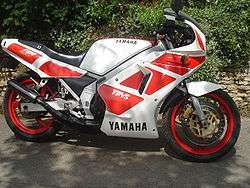Yamaha TZR250
 | |
| Manufacturer | Yamaha |
|---|---|
| Production | 1986 - 1999 |
| Predecessor | RD250/350LC, RD 350 YPVS |
| Class | Sport bike |
| Engine | Two-Stroke Parallel Twin YPVS |
| Transmission | 6 Speed Constant Mesh |
| Wheelbase | 1375 mm |
| Dimensions |
L: 2005 mm W: 660 mm |
| Seat height | 760 mm |
| Weight |
127.97 kg (dry) 144 kg (wet) |
| Fuel capacity | 16 L |

The Yamaha TZR250 is a motorcycle manufactured and produced by the Japanese motorcycle manufacturer Yamaha between 1986 and 1996.
Yamaha produced the road going two-stroke motorcycle, loosely based on the TZ250 Yamaha racing bike. Parallel-twin, reverse cylinder and finally V-twin variants were produced. It evolved as a natural replacement for the popular RD 250/Yamaha RD350LC series of the 1980s. It has the Yamaha Power Valve System (YPVS) which raises and lowers the exhaust port depending on the rpm of the engine. The YPVS servo motor starts to open at about 6,000rpm. In standard form 50 bhp is claimed at 10,000rpm. Although mid 40s is more realistic, and will not rev much above 9,500rpm in standard trim, owing to the restrictive standard exhausts and ignition boxes.
Racing
Still raced in the Yamaha Past Masters race series with the British racing club - BMCRC. Racing engines currently claiming circa 56 bhp @ 11,000rpm. Racing fuel ratios typically 1:30. Standard exhausts are difficult to improve on in terms of power and torque, but they are very large and impede ground clearance. Jolly Moto exhausts are popular replacements as they are lighter, produce similar performance, allow better ground clearance.
An F3 racing kit was produced for a few years which included ignition boxes, carbs and exh, helping increase maximum revs, power and torque.
History
Production started in June 1986. At a cost of around $6,000 new on release it was seen as an expensive bike for a 250 cc, but given that places such as Japan, Italy and Australia had 250 licensing laws in place one can imagine the stir that something that could hassle 750s on a track caused. The parallel twin 2MA variant being the UK variant and the 1KT model being the domestic Japanese variant. Variations between these two models being minimal, e.g. wording on the brake master cylinder in English or Japanese. Lighting arrangements were also different, to comply with UK type approval regulations, particularly the indicators were mounted on stalks rather than faired into the bodywork.
In 1989, the parallel twin reverse cylinder version, 3MA arrived, then in 1991-1996 the V-twins 3XV.
The 3XV came out in 8 variants with different carbs, ignitions, wet & dry clutches, 3 versions of power valves, cylinders and each depicted by different colour number boards on the side panels and front fairing. The versions names being 250R; 250RS; 250RSP; 250SP and 250SPR.
The variants closely followed the configuration of motor of the racing TZ250 of the time, sharing the same engine casings, frames and in some models the cylinders, carbs and power valves. Manufacture of TZR250s stopped in 1996.
External links
- Magazine Review of the 1987 Yamaha TZR250 released in Canada (Hosted by Chinoy of RD Dreams )
| Wikimedia Commons has media related to Yamaha TZR. |